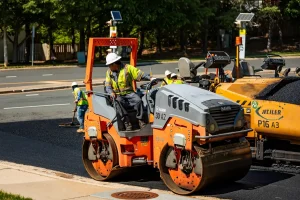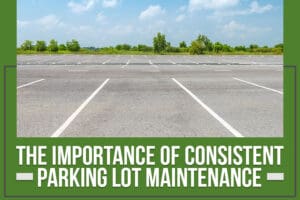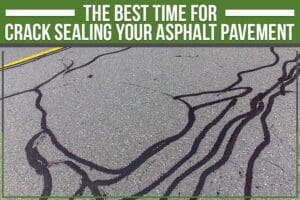Key Takeaways:
- A pothole is a depression in the roadway that can range in size from a few inches to several feet.
- Potholes form when water enters a crack in the pavement and freezes, expanding and causing the pavement to break.
- You can help prevent potholes by ensuring that your pavement is properly maintained.
- A pothole can be repaired using a pothole filler and a few simple tools.
- Some people attempt to fix potholes themselves in order to save money, but they don’t realize this is dangerous and can lead to expensive rework.
- It’s always recommended to call the professionals for the best and most long-lasting results.
We experience all four seasons in the United States, sometimes in the same month. And each season brings with it different weather-related hazards. One such hazard is potholes. Potholes can pop up any time of year, but they are particularly common in the winter and early spring when the freeze-thaw cycle causes water to seep into cracks in the road surface, expand when it freezes, and break up the pavement.
In this blog post, Brothers Paving & Concrete will take a closer look at how potholes form and how you can help prevent them.
Potholes: The What & Why
Wondering What Potholes Are?
Well, a pothole is a depression in the roadway that can range in size from a few inches to several feet. Potholes form when water slips into cracks in the pavement, freezes, & expands. This expansion ends up putting pressure on the surrounding pavement and can cause it to break up. The weight of heavy traffic passing over the weakened pavement can also contribute to its deterioration and the formation of potholes.
Where and When do Potholes Form?
Potholes are most commonly found in the springtime, after a long winter of freezing temperatures and fluctuating weather conditions.
Potholes can range in dimensions from a few inches to several feet, and they can be found just about anywhere there is asphalt pavement. But they are most common on streets and roads that see a lot of traffic and have been around for many years.
Types of Potholes You Should Be Aware Of
Here is a list of the common types of potholes and how they form:
- Type I potholes: These are the most common type of potholes. They occur when water slips into the cracks of the pavement and freezes. As the water expands, it creates an opening in the pavement. Traffic driving over this opening further weakens the pavement, and potholes form.
- Type II potholes: Type II potholes form when there’s a failure in the base or subbase layer of the pavement. This can take place due to poor drainage or compaction of the materials.
- Type III potholes: Type III potholes form when there’s a failure in the pavement itself. This pothole is usually caused by repetitive traffic driving over the same spot.
How We Can Help Prevent Potholes
There’re a few things you can do to help prevent potholes:
- Drive slowly and carefully: especially over areas of pavement that look like they might be weak or have already started to develop potholes: This helps to prevent further damage and, as a result, the formation of new potholes.
- Avoid driving over puddles: This can help prevent water from seeping into pavement cracks and weakening.
- Report any potholes you see: This helps ensure they’ll be fixed quickly and prevents them from worsening. You can usually report potholes to your city or county government.
- Fill small cracks in the pavement: This can help prevent water from seeping into the cracks and causing them to expand, which leads to potholes. You can buy crack-filling material at most hardware stores.
Did you know that potholes cost American taxpayers $3 billion each year?
How Professional Paving Companies Repair Potholes
Of course, professional pothole repair companies also use specialized equipment to fix potholes. Some of the methods they use include:
- Infrared Asphalt Repair: This method utilizes an infrared heating unit to heat up the surrounding asphalt so that it’s soft enough to fill. Professional pavement repair and maintenance companies have all the tools and equipment required to ensure proper asphalt repair.
- Hot Asphalt Patching: The company will bring hot asphalt to the job site and fill the pothole. They will then remove the asphalt around the pothole and seal the surface using hot asphalt.
Also, read Understanding Surface Milling and Its Benefits!

DIY Pothole Repair – Is it Recommended?
Some homeowners take a DIY approach to pothole repair in an effort to save money. But what they don’t realize is that this can actually end up costing them more in the long run. Here’s why you should avoid DIY pothole repair at all costs.
Bad News: You’re Not a Pothole Repair Expert
Just because you watched a YouTube video on pothole repair doesn’t make you an expert. In fact, attempting a DIY pothole repair is likely to do more harm than good. Why? For starters, unless you have the right tools and materials, your repair is not going to last. And even if you do have the right tools, most people don’t have the expertise necessary to properly assess the damage and make a repair that will stand up to inclement weather and heavy traffic.
Potholes are More Complicated Than You Think
Fixing potholes is actually quite complicated. They form when water seeps into cracks in the pavement and then freezes, expanding and weakening the pavement. As vehicles drive over the weakened pavement, it crumbles and forms a hole. So, to properly repair a pothole, you need to patch not only the hole itself but also address the underlying issue that caused the hole to form in the first place. Otherwise, you’re just going to end up with another pothole down the road.
Potholes Are a Safety Hazard
On top of being unsightly, potholes can also pose a serious safety hazard. If left unaddressed, potholes can cause flat tires, bent rims, suspension damage, and even accidents. When vehicles hit a large pothole at high speeds, it can cause them to lose control or even overturn. That’s why it’s always best to leave pothole repair to the professionals who have the training and experience necessary to do the job right.
Don’t risk your safety or your wallet by attempting DIY pothole repair. Potholes are more complicated than they might seem, and unless you’re a trained professional, you’re likely just going to end up making things worse. So, save yourself the trouble and call a professional pothole repair service next time you spot one on your property. Trust us, your wallet (and your car) will thank you later!
Get a Quote from DMV’s Leading Pothole Repair Company
Brothers Paving & Concrete is a leading provider of pothole repair services in DMV. We have the experience and equipment necessary to quickly and effectively repair potholes of all sizes.





